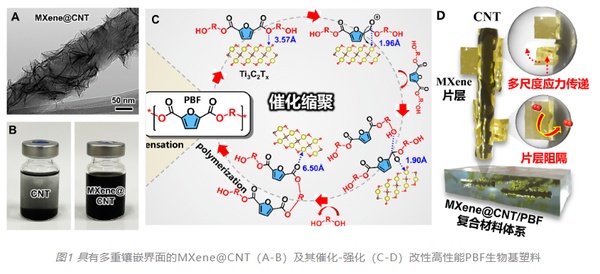Ningbo Institute of Materials Science has made new progress in the in-situ catalytic synthesis of bio-based furan polyesters.
Based on this, recently, the biobased polymer materials team at the Ningbo Institute of Materials Technology & Engineering, Chinese Academy of Sciences, building upon their research into spatially confined assembly and molecular-interface synergistic reinforcement of FDCA polyester nanocomposites, proposed a novel in-situ catalytic synthesis strategy for high-performance biobased furan polyester nanocomposites. This approach is capable of simultaneously enhancing the gas barrier, mechanical properties, and crystallization ability of the polyester.
The researchers innovatively developed a high-speed shearing technique to prepare dendritic MXene@CNT heterostructures with surface-embedded two-dimensional MXene nanosheets. This structure not only achieves the synergistic dispersion of MXene and carbon nanotubes (CNTs) but also inhibits the oxidation of MXene by forming C-O-Ti covalent bonds with residual hydroxyl groups in CNTs. Additionally, it exposes more active sites to enhance the catalytic and nucleation efficiency of MXene@CNT, while enabling mechanical interlocking and chemical bonding at multiscale interfaces for efficient stress transfer.

Subsequently, through an integrated catalytic-interface reinforcement strategy, the researchers prepared biobased plastics with a multiscale stress dissipation architecture, as shown in Figure 1. The biobased plastics, prepared by in-situ catalysis with a small amount (0.1-0.3 wt.%) of filler, showed simultaneous improvements in tensile strength (101 MPa), toughness (237%), and gas barrier properties (O2 barrier > 4 times that of PET). Thanks to the design and construction of the multiscale stress dissipation architecture, the biobased plastics also exhibited good reprocessing performance (maintaining 90% of their mechanical strength after 5 physical cycles), UV shielding function (blocking ~99% of UVB rays and ~80% of UVA rays), and solvent resistance (stable for >30 days in polar solvents), making them an ideal substitute for petroleum-based plastics.
【Copyright and Disclaimer】The above information is collected and organized by PlastMatch. The copyright belongs to the original author. This article is reprinted for the purpose of providing more information, and it does not imply that PlastMatch endorses the views expressed in the article or guarantees its accuracy. If there are any errors in the source attribution or if your legitimate rights have been infringed, please contact us, and we will promptly correct or remove the content. If other media, websites, or individuals use the aforementioned content, they must clearly indicate the original source and origin of the work and assume legal responsibility on their own.
Most Popular
-

List Released! Mexico Announces 50% Tariff On 1,371 China Product Categories
-

Nissan Cuts Production of New Leaf EV in Half Due to Battery Shortage
-

New Breakthrough in Domestic Adiponitrile! Observing the Rise of China's Nylon Industry Chain from Tianchen Qixiang's Production
-

Dow, Wanhua, Huntsman Intensively Raise Prices! Who Controls the Global MDI Prices?
-

Mexico officially imposes tariffs on 1,400 chinese products, with rates up to 50%






